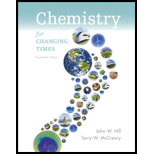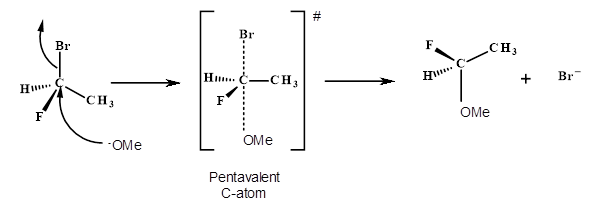
Chemistry For Changing Times (14th Edition)
14th Edition
ISBN: 9780321972026
Author: John W. Hill, Terry W. McCreary
Publisher: PEARSON
expand_more
expand_more
format_list_bulleted
Question
Chapter 4, Problem 4.7CTE
Interpretation Introduction
Interpretation:
Whether the claim about a compound containing a pentavalent carbon atom is valid or not should be determined.
Concept Introduction:
The electronic configuration of carbon is thus the number of valence electrons are four (4). So in the maximum compound, it exists as a tetravalent atom, but due to the presence of one vacant p-orbital, the pentavalent carbon is possible. The maximum exists as an intermediate compound in some reaction, which can be seen in the details reaction mechanism.
thus the number of valence electrons are four (4). So in the maximum compound, it exists as a tetravalent atom, but due to the presence of one vacant p-orbital, the pentavalent carbon is possible. The maximum exists as an intermediate compound in some reaction, which can be seen in the details reaction mechanism.
 |
Expert Solution & Answer
Want to see the full answer?
Check out a sample textbook solution
Students have asked these similar questions
7
Draw the starting alkyl bromide that would produce this alkyne
under these conditions.
F
Drawing
1. NaNH2, A
2. H3O+
£
4 Temps to rise
Tomorrow
Q Search
H2
7
Comment on the general features of the predicted (extremely simplified) ¹H-
NMR spectrum of lycopene that is provided below.
00
6
57
PPM
3
2
1
0
Indicate the compound formula: dimethyl iodide (propyl) sulfonium.
Chapter 4 Solutions
Chemistry For Changing Times (14th Edition)
Ch. 4 - Prob. 1RQCh. 4 - Prob. 2RQCh. 4 - What are the structural differences among chlorine...Ch. 4 - Prob. 4RQCh. 4 - What are the charges on simple ions formed from...Ch. 4 - Prob. 6RQCh. 4 - In what group of the periodic table would elements...Ch. 4 - Prob. 8RQCh. 4 - Prob. 9RQCh. 4 - Prob. 10P
Ch. 4 - 11. Write Lewis symbols for each of the following...Ch. 4 - Write the Lewis symbol for each species in the...Ch. 4 - Prob. 13PCh. 4 - Prob. 14PCh. 4 - Prob. 15PCh. 4 - Prob. 16PCh. 4 - Prob. 17PCh. 4 - Prob. 18PCh. 4 - Prob. 19PCh. 4 - Prob. 20PCh. 4 - Prob. 21PCh. 4 - Prob. 22PCh. 4 - Prob. 23PCh. 4 - Prob. 24PCh. 4 - There are two common binary ionic compounds formed...Ch. 4 - Prob. 26PCh. 4 - Prob. 27PCh. 4 - Prob. 28PCh. 4 - Prob. 29PCh. 4 - Prob. 30PCh. 4 - Prob. 31PCh. 4 - Prob. 32PCh. 4 - Use Lewis dot symbols to show the sharing of...Ch. 4 - Prob. 34PCh. 4 - Prob. 35PCh. 4 - Prob. 36PCh. 4 - Prob. 37PCh. 4 - Prob. 38PCh. 4 - 39. Supply a formula for the name or a name for...Ch. 4 - Prob. 40PCh. 4 - Prob. 41PCh. 4 - Prob. 42PCh. 4 - Prob. 43PCh. 4 - Prob. 44PCh. 4 - Prob. 45PCh. 4 - Prob. 46PCh. 4 - Prob. 47PCh. 4 - Prob. 48PCh. 4 - Prob. 49PCh. 4 - Prob. 50PCh. 4 - Prob. 51PCh. 4 - Prob. 52PCh. 4 - Classify the bonds in the following as ionic or...Ch. 4 - Prob. 54PCh. 4 - Prob. 55PCh. 4 - Prob. 56PCh. 4 - Prob. 57PCh. 4 - Prob. 58PCh. 4 - Prob. 59PCh. 4 - Prob. 60PCh. 4 - Prob. 61PCh. 4 - Prob. 62PCh. 4 - Prob. 63PCh. 4 - Prob. 64PCh. 4 - Prob. 65PCh. 4 - Prob. 66PCh. 4 - Prob. 67PCh. 4 - Prob. 68PCh. 4 - Prob. 69PCh. 4 - Prob. 70PCh. 4 - Prob. 71PCh. 4 - Prob. 72APCh. 4 - Prob. 73APCh. 4 - Prob. 74APCh. 4 - Prob. 75APCh. 4 - Prob. 76APCh. 4 - Prob. 77APCh. 4 - Prob. 78APCh. 4 - Prob. 79APCh. 4 - Prob. 80APCh. 4 - Prob. 81APCh. 4 - Prob. 82APCh. 4 - Prob. 83APCh. 4 - Prob. 84APCh. 4 - Prob. 85APCh. 4 - Prob. 86APCh. 4 - Prob. 87APCh. 4 - Prob. 88APCh. 4 - Prob. 89APCh. 4 - Prob. 90APCh. 4 - Prob. 91APCh. 4 - Prob. 92APCh. 4 - Prob. 93APCh. 4 - Prob. 4.1CTECh. 4 - Prob. 4.2CTECh. 4 - 4.3 Sodium chloride (NaCI) is a metal-nonmetal...Ch. 4 - Prob. 4.4CTECh. 4 - Prob. 4.5CTECh. 4 - Prob. 4.6CTECh. 4 - Prob. 4.7CTECh. 4 - Prob. 4.8CTECh. 4 - Prob. 4.9CTECh. 4 - Prob. 4.10CTECh. 4 - Prob. 1CGPCh. 4 - Prob. 2CGPCh. 4 - Prepare a PowerPoint, poster, or other...Ch. 4 - Prob. 4CGPCh. 4 - Prob. 5CGPCh. 4 - Prob. 1CHQCh. 4 - Prob. 2CHQCh. 4 - Prob. 3CHQ
Knowledge Booster
Learn more about
Need a deep-dive on the concept behind this application? Look no further. Learn more about this topic, chemistry and related others by exploring similar questions and additional content below.Similar questions
arrow_back_ios
SEE MORE QUESTIONS
arrow_forward_ios
Recommended textbooks for you
 ChemistryChemistryISBN:9781305957404Author:Steven S. Zumdahl, Susan A. Zumdahl, Donald J. DeCostePublisher:Cengage Learning
ChemistryChemistryISBN:9781305957404Author:Steven S. Zumdahl, Susan A. Zumdahl, Donald J. DeCostePublisher:Cengage Learning ChemistryChemistryISBN:9781259911156Author:Raymond Chang Dr., Jason Overby ProfessorPublisher:McGraw-Hill Education
ChemistryChemistryISBN:9781259911156Author:Raymond Chang Dr., Jason Overby ProfessorPublisher:McGraw-Hill Education Principles of Instrumental AnalysisChemistryISBN:9781305577213Author:Douglas A. Skoog, F. James Holler, Stanley R. CrouchPublisher:Cengage Learning
Principles of Instrumental AnalysisChemistryISBN:9781305577213Author:Douglas A. Skoog, F. James Holler, Stanley R. CrouchPublisher:Cengage Learning Organic ChemistryChemistryISBN:9780078021558Author:Janice Gorzynski Smith Dr.Publisher:McGraw-Hill Education
Organic ChemistryChemistryISBN:9780078021558Author:Janice Gorzynski Smith Dr.Publisher:McGraw-Hill Education Chemistry: Principles and ReactionsChemistryISBN:9781305079373Author:William L. Masterton, Cecile N. HurleyPublisher:Cengage Learning
Chemistry: Principles and ReactionsChemistryISBN:9781305079373Author:William L. Masterton, Cecile N. HurleyPublisher:Cengage Learning Elementary Principles of Chemical Processes, Bind...ChemistryISBN:9781118431221Author:Richard M. Felder, Ronald W. Rousseau, Lisa G. BullardPublisher:WILEY
Elementary Principles of Chemical Processes, Bind...ChemistryISBN:9781118431221Author:Richard M. Felder, Ronald W. Rousseau, Lisa G. BullardPublisher:WILEY

Chemistry
Chemistry
ISBN:9781305957404
Author:Steven S. Zumdahl, Susan A. Zumdahl, Donald J. DeCoste
Publisher:Cengage Learning

Chemistry
Chemistry
ISBN:9781259911156
Author:Raymond Chang Dr., Jason Overby Professor
Publisher:McGraw-Hill Education

Principles of Instrumental Analysis
Chemistry
ISBN:9781305577213
Author:Douglas A. Skoog, F. James Holler, Stanley R. Crouch
Publisher:Cengage Learning

Organic Chemistry
Chemistry
ISBN:9780078021558
Author:Janice Gorzynski Smith Dr.
Publisher:McGraw-Hill Education

Chemistry: Principles and Reactions
Chemistry
ISBN:9781305079373
Author:William L. Masterton, Cecile N. Hurley
Publisher:Cengage Learning

Elementary Principles of Chemical Processes, Bind...
Chemistry
ISBN:9781118431221
Author:Richard M. Felder, Ronald W. Rousseau, Lisa G. Bullard
Publisher:WILEY
Periodic Properties of Elements | Chemistry | IIT-JEE | NEET | CBSE | Misostudy; Author: Misostudy;https://www.youtube.com/watch?v=L26rRWz4_AI;License: Standard YouTube License, CC-BY
Periodic Trends: Electronegativity, Ionization Energy, Atomic Radius - TUTOR HOTLINE; Author: Melissa Maribel;https://www.youtube.com/watch?v=0h8q1GIQ-H4;License: Standard YouTube License, CC-BY